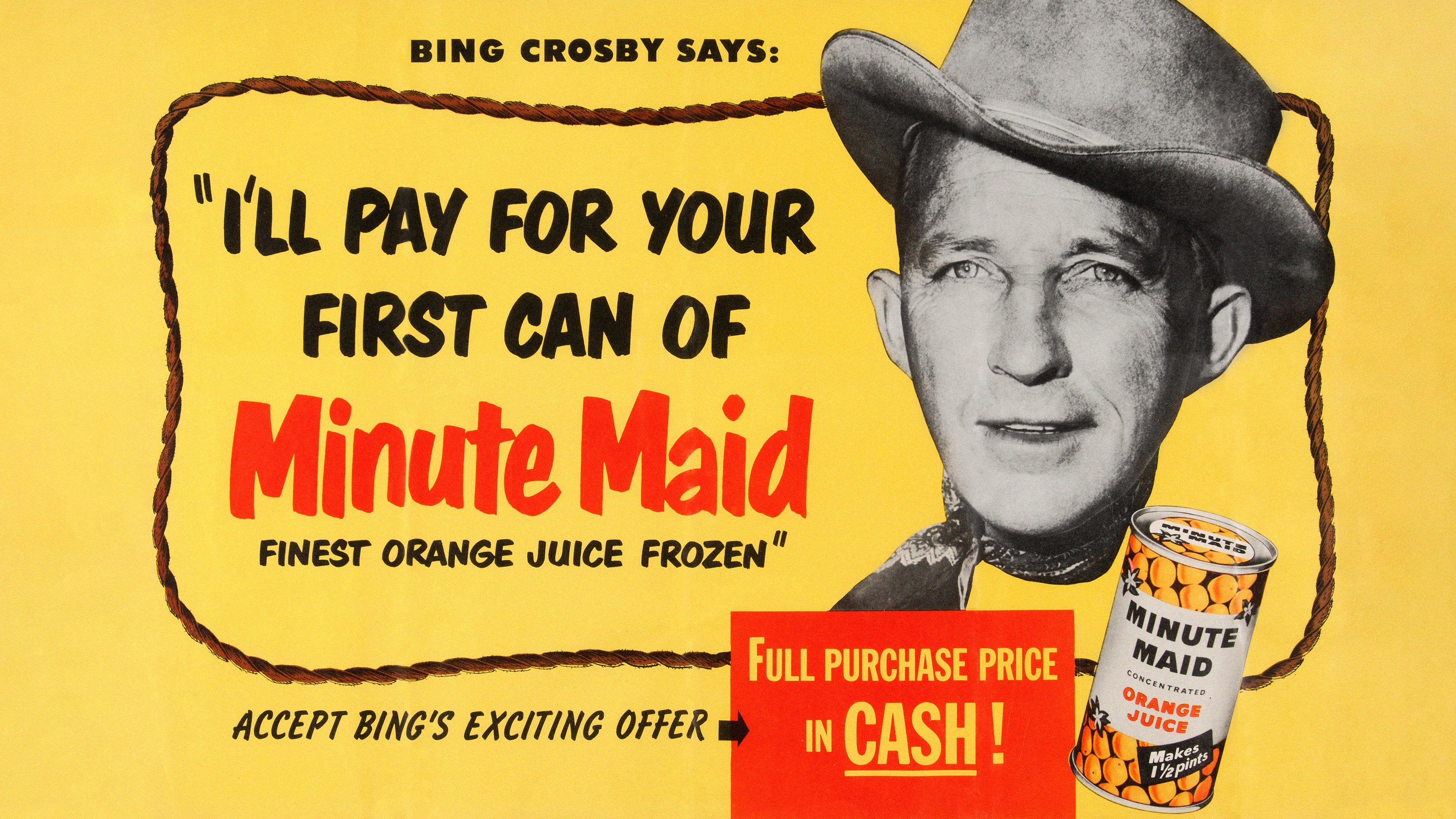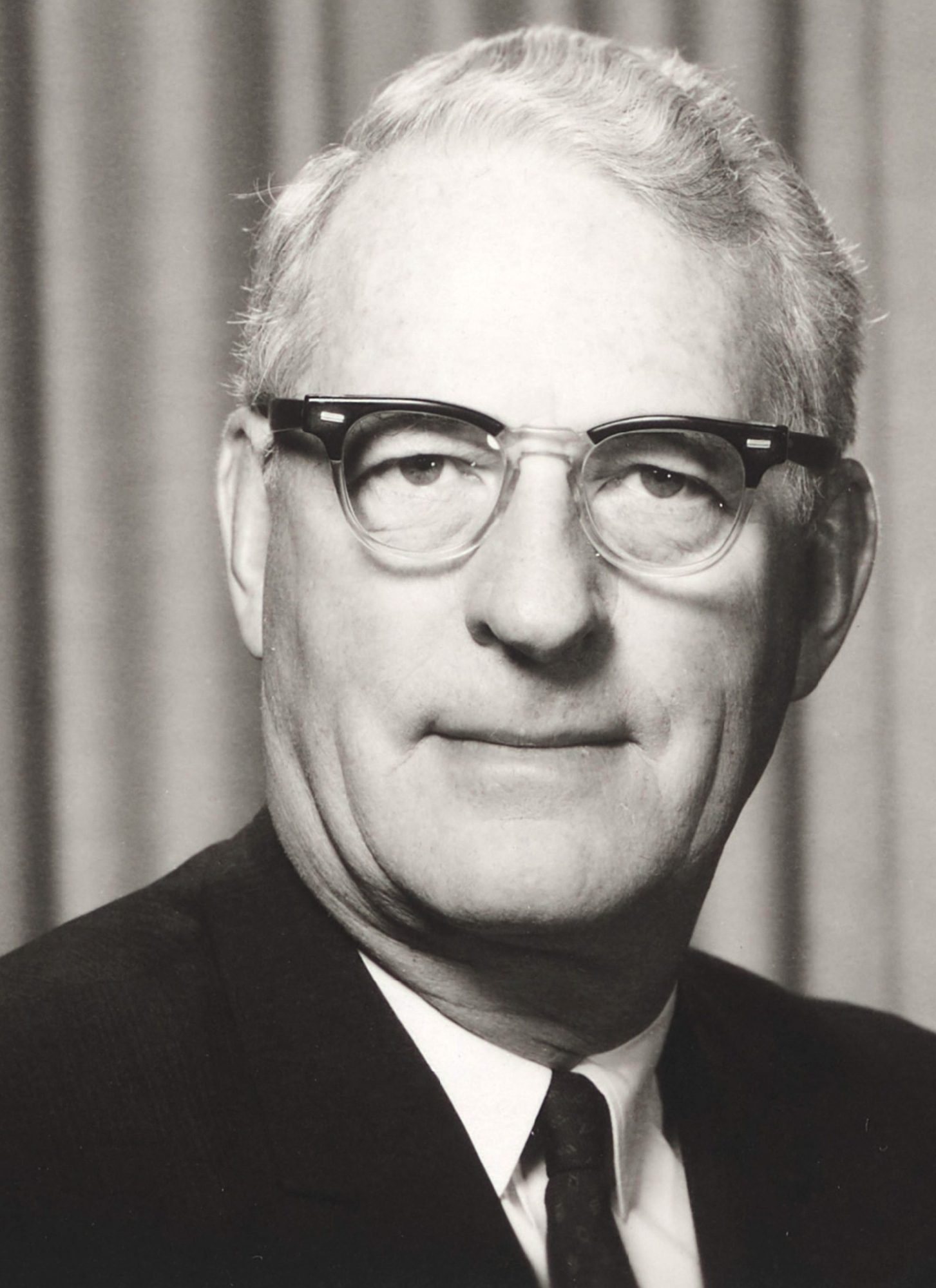A juicy story
How Richard Morse ’33 put frozen orange juice on the American breakfast table—with a little help from Bing Crosby.

In the 1940s, few entertainers were as well loved as actor and singer Bing Crosby, the star of films such as Going My Way. When he became the voice of Minute Maid orange juice in 1948, sales skyrocketed, jumping from under $3 million to nearly $30 million within three years. For three decades, Crosby’s smooth baritone narrated radio and television commercials, including many portraying his own family drinking reconstituted frozen orange juice—not only around the breakfast table but also while doing things like playing golf in the backyard and camping. To see the commercials, you’d never guess that Minute Maid’s backstory includes a stock market crash, World War II, and fish liver oil.
The man behind the juice was Richard Morse, who graduated from MIT’s physics program in 1933. It was “the depths of the Depression,” says his son, Ken Morse ’68. “And only two kids in his class had job offers.” Richard was one of the lucky two, but he turned the job down to pursue graduate studies in Munich, Germany. He’d long been a ham radio buff and planned to study communication technology with Germany’s leading experts.

Morse’s timing was, of course, inopportune. The year he’d graduated, Hitler had been appointed chancellor of Germany, and by 1935 it became clear to Morse that war was inevitable. He returned to the US and found a job at Eastman Kodak in Rochester, New York, where he researched ways to make color movies, among other things. At the time, Kodak and General Mills jointly owned a subsidiary called Distillation Products, Inc. (DPI) that used vacuum technology to produce high-potency vitamin concentrates from vegetable and fish liver oils. (Kodak had gotten into the vacuum business with the goal of removing gases from film canisters to prolong shelf life and then looked for other applications.) He became fascinated with vacuums while working with DPI’s Kenneth Hickman, a leading expert on the subject.
But Morse grew frustrated by the slow pace of research in a large company, and on April 1, 1940, he quit. “Nobody believed it!” Ken says. Rochester was a company town—and no one walked away from a job at Kodak. But Richard was serious, despite having resigned on April Fools’ Day. He moved back to Boston and started a technology development company called National Research Corporation (NRC). It ultimately settled in Kendall Square, just down the street from his alma mater.
NRC quickly found uses for vacuum technology, including removing impurities from metals and making powdered drugs. Morse’s expertise also drew the attention of former MIT vice president Vannevar Bush, EGD 1916, head of the Office of Scientific Research and Development, which President Roosevelt had established at Bush’s urging in 1941 to ready the country for war. Bush asked Morse to help develop a vacuum pump of unprecedented strength—a component needed to build the atomic bomb. “I heard my father say later that he thought Van had gone off the deep end. There was no way you could have such vacuums!” Ken Morse says. But perseverance paid off: working with DPI and Westinghouse, NRC designed and built the vacuums needed for the uranium separation process in the Manhattan Project.
Although consumer acceptance of frozen foods had been established, Minute Maid didn’t want to repeat the mistake NRC had made with coffee. So it recruited a professional to market the frozen orange juice concentrate.
Meanwhile, Morse also turned his attention toward home life—to be specific, the breakfast table. His first foray into the food industry, soon after he founded NRC, was instant coffee. As Ken Morse recalls, other companies had tried powdering coffee by boiling away the water, but the flavor got lost. By putting coffee in a vacuum, scientists at NRC were able to lower its boiling point so that water would evaporate before the coffee reached a temperature that destroyed its flavor. Richard Morse and his scientists—whom Ken describes as “techie guys with their thin little ties and white shirts”—went out to local supermarkets to peddle their new product.
NRC’s employees were talented scientists, but their people skills were a bit raw. Shoppers thought freeze-dried coffee lacked the aroma of regular coffee, and the researchers had limited success persuading them to make the switch. In the 1960s, Maxwell House made instant coffee a pantry staple, but NRC didn’t have the marketing prowess to get its version off the ground.
While the coffee project didn’t pay off, another food-processing venture proved wildly successful. The US Army wanted to send powdered orange juice overseas to troops fighting in World War II. And Morse was convinced that orange powder produced through vacuum dehydration had great commercial potential. He bet it would taste—and sell—better than canned orange juice, whose flavor was compromised by the heat needed for pasteurization.
So NRC set about perfecting a two-step technique, first concentrating and then powdering the juice. Ken Morse and other NRC family members served as test subjects for the early juice experiments. At first, his father tried to be nice to citrus growers by using less popular fruits like tangerines and grapefruit, but Ken remembers the results of these early trials as “dismal duds.” Once NRC zeroed in on a successful process, Morse set up a subsidiary called Florida Foods—which was later renamed Minute Maid—to produce powdered orange juice. But the war ended before the Army shipped any to the troops, so the company focused on finding a domestic market for its frozen concentrate instead.
Although consumer acceptance of frozen foods had been established, Minute Maid didn’t want to repeat the mistake NRC had made with coffee. So it tapped into the growing popularity of television and recruited a professional to market the concentrate. Bing Crosby, one of the most likable people in the entertainment industry, signed on to help and went on to voice—and often appear in—commercials that aired into the 1970s.
Perhaps Morse learned something from watching Crosby market Minute Maid. Not long after the Russians launched Sputnik in 1957, his career shifted into a phase that drew heavily on interpersonal skills. As Ken Morse and his father observed the satellite crossing the night sky, Richard’s clenched hands revealed the anger that filled him when he thought the US might lose the space race. “It wasn’t like a surface rage. It was really deep in his heart,” Ken recalls.
Soon, the Eisenhower administration requested Richard Morse’s help to prevent that from happening. Morse left NRC to become the director of research and development for the US Army, and later the assistant secretary of the Army. Ken Morse says one of his father’s biggest triumphs at the Pentagon was convincing the Army Signal Corps to install an intercom system that allowed him to speak directly to his peers in different branches of the military, cutting through layers of bureaucracy and increasing efficiency and inter-service collaboration. In 1961, soon after leaving the military, Morse returned to MIT as a senior lecturer at the Sloan School of Management, where he mentored many entrepreneurs, including Genentech cofounder Robert Swanson ’69, SM ’70, and started an entrepreneurship course called New Enterprises. It’s still offered today, making it one of the Institute’s longest-running classes.
Throughout his life, Morse maintained the interest in ham radio that had brought him to MIT as an undergrad. The backyard of Ken Morse’s childhood home featured a 20-meter-wide antenna mounted on an 85-foot pole that his father used to talk with people as far away as Bhutan. One part technology and one part communication, the hobby was a microcosm of Morse’s career. And true to form, he enjoyed it right up to the end.
Keep Reading
Most Popular
Large language models can do jaw-dropping things. But nobody knows exactly why.
And that's a problem. Figuring it out is one of the biggest scientific puzzles of our time and a crucial step towards controlling more powerful future models.
How scientists traced a mysterious covid case back to six toilets
When wastewater surveillance turns into a hunt for a single infected individual, the ethics get tricky.
The problem with plug-in hybrids? Their drivers.
Plug-in hybrids are often sold as a transition to EVs, but new data from Europe shows we’re still underestimating the emissions they produce.
Stay connected
Get the latest updates from
MIT Technology Review
Discover special offers, top stories, upcoming events, and more.